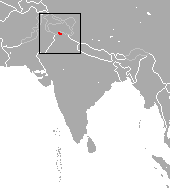Kashmir gray langur
| Kashmir gray langur | |
|---|---|
| Scientific classification | |
| Domain: | Eukaryota |
| Kingdom: | Animalia |
| Phylum: | Chordata |
| Class: | Mammalia |
| Order: | Primates |
| Suborder: | Haplorhini |
| Infraorder: | Simiiformes |
| Family: | Cercopithecidae |
| Genus: | Semnopithecus |
| Species: | S. ajax
|
| Binomial name | |
| Semnopithecus ajax | |

| |
| Kashmir gray langur range | |
The Kashmir gray langur (Semnopithecus ajax) is an
It has been reported from Jammu and Kashmir and Himachal Pradesh in northwestern India but evidence indicates it only occurs in the Chamba Valley in Himachal Pradesh. Because of its restricted range, fragmented population and threats from human agriculture and development activities it is listed as Endangered in the IUCN Red List.[1] In Pakistan it occurs in Machiara National Park.[3]
It was formerly considered a subspecies of
Ecology and behaviour
It is
The
Although most Asian colobine groups comprise only a single adult male and multiple females, multimale groups are known to occur within Semnopithecus species. In Kashmir gray langurs, multimale groups may include as many as five adult males. Females initiate copulation by soliciting a male, but not all solicitations result in copulation.[6]
References
- ^ . Retrieved 17 January 2022.
- ^ OCLC 62265494.
- ^ Minhas, R. A.; Ahmed, K. B.; Awan, M. S.; Dar, N. I. (2010). "Social organization and reproductive biology of Himalayan grey langur (Semnopithecus entellus ajax) in Machiara National Park, Azad Kashmir (Pakistan)". Pakistan Journal of Zoology. 42: 143–156.
- OCLC 62265494.
- PMID 23408044.
- ^ ISBN 978-0-19-517133-4.

